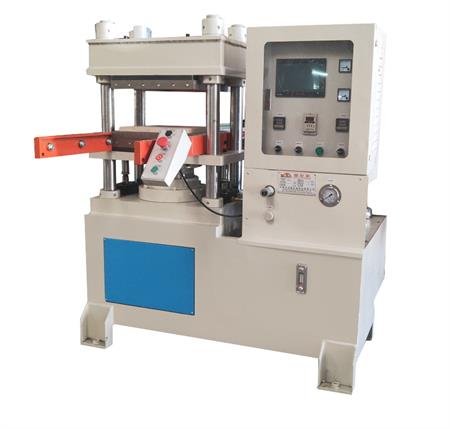

Rubber Curing Machine is used to vulcanize rubber, significantly improving its elasticity, strength and wear resistance. Through heating and chemical reactions, the vulcanization process enhances the rubber's weather resistance, oxidation resistance and chemical corrosion resistance, making it more durable and easy to process. This process not only improves the elasticity and resilience of rubber, but also makes it suitable for manufacturing a variety of rubber products such as tires, seals and conveyor belts to meet the needs of different industries.
Model | YX-DJ63T-1 |
Hot plate specification | 400*400mm |
Hot plate spacing | 200mm |
Cylinder diameter | 200mm |
Machine structure | Four column/single head/double head model |
System pressure | 18MPa |
Heating system | Imported electric heating tube |
Power supply specification | 380V/50HZ |
YX-DJ63T-1 rubber Vulcanizer is an efficient and reliable equipment designed for rubber vulcanization process. Its main parameters include:
Hot plate specifications: 400 x 400 mm, providing a wide range of heating surfaces, suitable for rubber products of different sizes.
Hot plate spacing: 200 mm, allowing flexible adjustment to meet the vulcanization needs of rubber of different thicknesses.
Cylinder diameter: 200 mm, ensuring stable pressure application and improving vulcanization effect.
Machine structure: adopts a four-column design, providing a solid support structure, and can choose single-head or double-head models to meet different production needs.
System pressure: 18 MPa, providing high pressure conditions to ensure full vulcanization of rubber.
Heating system: equipped with imported electric heating tubes to ensure uniform and efficient heating.
Power supply specifications: 380V, 150Hz, adapting to industrial standard power supply, ensuring stable operation of the equipment.
This rubber vulcanizer can significantly improve the elasticity, strength and durability of rubber products through its precise heating and pressure control, and is widely used in the production of rubber products such as tires, seals, conveyor belts, etc. Whether it is a single-head or double-head model, the YX-DJ63T-1 can provide high-quality vulcanization results to meet diverse industrial needs.
Detailed parameters
Essential details | |||
Place of Origin | China | Weight (KG) | 1300 KG |
Type | Vulcanizer | Applicable Industries | Hotels, Machinery Repair Shops, Home Use |
Condition | New | Showroom Location | None |
Video outgoing-inspection | Provided | Model | YX-DJ63T-1 |
Machinery Test Report | Provided | Hot plate specification | 400*400mm |
Warranty of core components | 1 Year | Hot plate spacing | 200mm |
Core Components | PLC | Cylinder diameter | 200mm |
Voltage | 300V/50HZ | Motor power | 4KW |
Dimension(L*W*H) | 1.5*1.4*1.5(m) | Temperature range | Normal temperature -350°C |
Warranty | 1 Year | Working level | Upper and lower layer |
Key Selling Points | Automatic | Machine structure | Four column/single head/double head model |
Power (kW) | 4 kW | System pressure | 18MPa |
Calibrating a Rubber Heat Press involves adjusting its settings to match the specific requirements of your application. This typically includes configuring the temperature, pressure, and time settings to ensure that the rubber products undergo the desired transformation. The exact calibration process can vary between machines, so it's crucial to consult the equipment manual or seek guidance from a technician experienced in the calibration process. Proper calibration is essential to achieve consistent and high-quality results in your rubber processing.
Yes, there are energy-efficient Rubber Heat Press models available in the market. These machines are designed with advanced insulation materials and energy-saving features to minimize electricity consumption while maintaining optimal performance. They are not only environmentally friendly but also cost-effective, making them a wise choice for businesses looking to reduce their energy expenses.
When selecting a Rubber Heat Press, prioritize safety features to ensure operator protection and safe machine operation. Look for features such as emergency stop buttons that allow for immediate shutdown in case of issues, pressure relief valves to prevent over-pressurization, and safety interlocks that ensure the press cannot be operated when safety guards are open. These safety measures help prevent accidents and injuries during machine use, making the workplace safer for operators.
The duration of a pressing cycle with a Rubber Heat Press can vary widely based on several factors. These include the type and thickness of the rubber material, the desired properties, and the specific machine's capabilities. Some pressing cycles may be completed in just a few minutes, while others, especially for larger or more complex products, can take several hours. It's essential to refer to your machine's documentation for precise cycle times related to your application.
Yes, Rubber Heat Presses are designed to accommodate various molds or platens, providing flexibility for producing different product shapes and sizes. This versatility allows manufacturers to adapt the machine to meet the specific requirements of their various rubber product designs. By using different molds, you can efficiently produce a wide range of rubber components with distinct shapes and characteristics.
Common issues with Rubber Heat Presses may include uneven pressure distribution, temperature variations, or problems with the heating elements. To address these problems, it's advisable to consult the machine's user manual, which often contains troubleshooting guides specific to the model. Additionally, if issues persist, it's recommended to seek assistance from a qualified technician or the equipment manufacturer. Prompt troubleshooting and maintenance are crucial to ensure the smooth and reliable operation of the press.
When purchasing a Rubber Heat Press, it's essential to look for safety certifications to ensure compliance with industry standards and safety regulations. A common safety certification to look for is CE (Conformité Européene), which signifies compliance with European safety standards. Depending on your location and industry, there may be other relevant safety certifications and standards to consider. Ensuring that your Rubber Heat Press meets these safety requirements is crucial to providing a safe working environment and maintaining regulatory compliance.